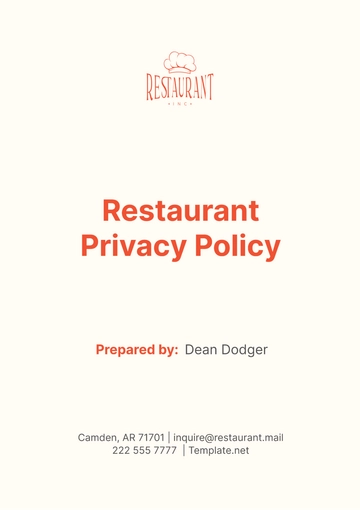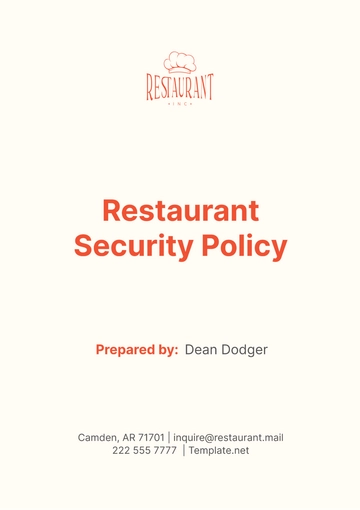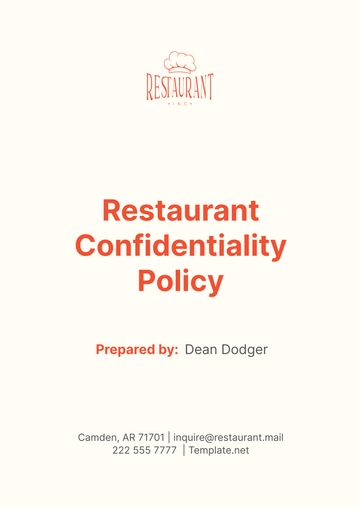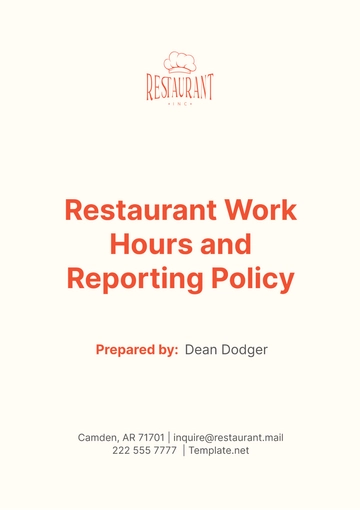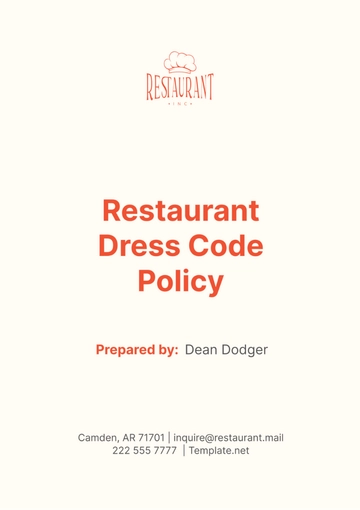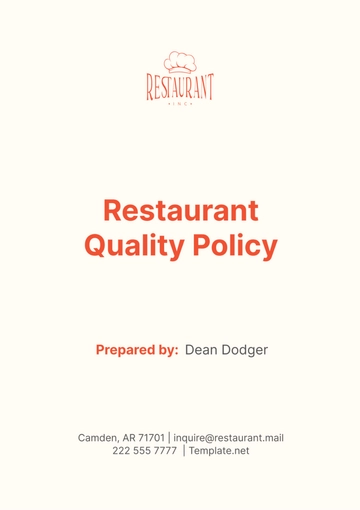Free Restaurant Complaints Policy

I. Introduction
A. Purpose
The purpose of this Complaints Policy is to ensure that all customer complaints are managed in a structured, consistent, and timely manner. Our ultimate aim is to enhance customer satisfaction and drive continuous improvement in our service quality. We believe that effectively handling complaints is crucial to maintaining a positive relationship with our customers and improving our services based on their feedback.
B. Scope
This policy applies to all complaints received from customers regarding any aspect of our restaurant services. This includes, but is not limited to, complaints about food quality, service, cleanliness, and overall customer experience. We are committed to addressing all valid complaints and taking appropriate action to rectify any issues.
II. Policy Statement
At [Your Company Name], we are committed to providing high-quality services to our customers. We understand that there may be times when our customers are dissatisfied with our service for various reasons. In such cases, we have procedures in place to promptly and effectively address their concerns. We view each complaint as an opportunity to improve our services and enhance customer satisfaction.
Customers can share their complaints by contacting us via email at [Your Company Email] or call [Your Company Number]. We assure our customers that all complaints will be taken seriously, and every effort will be made to resolve them in a satisfactory manner.
III. Roles and Responsibilities
The roles and responsibilities section outlines the duties of different members of our team in handling complaints. The following table provides a detailed breakdown:
Role | Responsibility |
|---|---|
All Staff | Report and record complaints and assist in investigations. |
Managers | Lead investigations, communicate with complainants, and ensure resolutions are implemented. |
Management | Oversee the complaints process, review complaints logs and resolutions, and implement any necessary changes to policies or procedures. |
A. All Staff
All staff members play a crucial role in our complaint management process. They are the first point of contact for our customers and are responsible for reporting and recording complaints. They also assist in investigations by providing relevant information and insights. Their cooperation and commitment are essential to resolving complaints effectively and maintaining a positive relationship with our customers.
B. Managers
Managers have a significant role in leading investigations into complaints. They communicate directly with complainants, ensuring that their concerns are heard and understood. They also ensure that appropriate resolutions are implemented, following up to confirm that the complainant is satisfied with the outcome. Their leadership and problem-solving skills are crucial to the successful resolution of complaints.
C. Management
The management team oversees the entire complaints process. They review complaint logs and resolutions to identify trends and areas for improvement. They also implement any necessary changes to policies or procedures to prevent similar complaints in the future. Their strategic oversight ensures that our complaint management process is effective and continuously improving.
The roles and responsibilities ensure that all complaints are handled promptly and effectively. Each role, from the staff to the management, plays a crucial part in this process. By clearly defining these roles and responsibilities, we can ensure that all team members understand their duties and contribute to the successful resolution of complaints.
Moreover, this structure allows us to learn from each complaint and use this information to improve our services. By reviewing complaints and resolutions, we can identify trends, address recurring issues, and implement changes to prevent similar complaints in the future. This continuous improvement approach is key to enhancing customer satisfaction and building a positive reputation for [Your Company Name].
IV. Procedure
The procedure for handling complaints is a critical part of our Restaurant Complaints Policy. It ensures that all complaints are handled in a consistent and systematic manner. The following table outlines the steps involved in our complaint handling procedure:
No. | Step |
|---|---|
1 | Receiving the Complaint |
2 | Acknowledgement |
3 | Investigation |
4 | Resolution |
A. Receiving the Complaint
The first step in our procedure is receiving the complaint. This involves recording the details of the complaint, including the nature of the issue, the date and time it occurred, and any other relevant information. Our staff are trained to handle complaints professionally and empathetically, ensuring that the customer feels heard and understood.
B. Acknowledgement
The second step is acknowledging the complaint. We aim to acknowledge all complaints within 24 hours of receipt. This acknowledgement reassures the customer that their complaint has been received and is being taken seriously. It also provides an opportunity to clarify any details and to set expectations about the next steps.
C. Investigation
The third step is the investigation. This involves looking into the complaint to understand what happened and why. Depending on the nature of the complaint, this may involve reviewing CCTV footage, speaking with staff, or inspecting physical evidence. The goal of the investigation is to gather all the facts so that an informed decision can be made.
D. Resolution
The final step is resolution. This involves communicating the outcome of the investigation to the customer and explaining what actions have been or will be taken. The resolution should address the customer’s complaint and, where possible, exceed their expectations to turn a negative experience into a positive one.
The total duration of this procedure will vary depending on the nature and complexity of the complaint, but we aim to resolve all complaints within 7 working days.
This procedure ensures that all complaints are handled promptly and effectively, leading to improved customer satisfaction. It also provides valuable feedback that can be used to improve our services and prevent similar complaints in the future. By following this procedure, we demonstrate our commitment to customer service and our willingness to learn from our mistakes.
V. Confidentiality
Confidentiality is a key aspect of our complaints handling process. We are committed to maintaining the highest level of confidentiality when dealing with customer complaints.
A. Personal Information
We understand the importance of protecting personal information. When a customer makes a complaint, they may need to provide personal information to help us investigate the issue. This information will be handled with the utmost care and respect for the customer’s privacy.
Collection of Information: We only collect personal information that is necessary to investigate the complaint. This may include the customer’s name, contact details, and details of the complaint.
Use of Information: The personal information collected will only be used for the purpose of investigating and resolving the complaint. It will not be used for any other purpose without the customer’s consent.
Disclosure of Information: Personal information will only be disclosed to staff members who are directly involved in handling the complaint. We will not disclose personal information to any third parties unless required by law.
B. Confidentiality of the Complaint
In addition to protecting personal information, we also maintain the confidentiality of the complaint itself.
Internal Confidentiality: Within our restaurant, the details of the complaint will only be shared with staff members who need to know in order to resolve the issue. This ensures that the complaint is handled in a discreet and professional manner.
External Confidentiality: We will not disclose the details of the complaint to anyone outside of our restaurant without the customer’s consent. This includes not publicly acknowledging that a complaint has been received or discussing the details of the complaint in a public forum.
VI. Continuous Improvement
Continuous improvement is a key principle of our policy. We view each complaint as an opportunity to learn and improve our services.
A. Feedback Analysis
Feedback analysis is a crucial part of our continuous improvement process. It involves:
Identifying Patterns: We regularly analyze feedback from complaints to identify patterns and trends. This helps us understand the common issues that customers face and the areas where we need to improve. By identifying these patterns, we can target specific areas for improvement and develop strategies to address these issues.
Implementing Changes: Based on our analysis, we implement changes to our services, policies, or procedures as needed. This could include revising our menu, retraining our staff, or improving our restaurant’s ambiance. By making these changes, we can directly address the issues raised in complaints and enhance our overall service quality.
Monitoring Impact: After implementing changes, we monitor their impact on customer satisfaction and complaint rates. This allows us to assess the effectiveness of our improvements and make further adjustments as needed.
B. Staff Training
Staff training is another important aspect of our continuous improvement process. It includes:
Regular Training Sessions: We conduct regular training sessions for our staff based on the feedback we receive. This ensures that our staff are equipped with the skills and knowledge they need to provide excellent service.
Learning from Mistakes: We encourage our staff to learn from mistakes and use complaints as an opportunity for growth and development. We believe that this fosters a positive work culture where staff are motivated to continuously improve.
Updating Training Programs: As part of our commitment to continuous improvement, we regularly update our training programs to reflect the feedback we receive and the latest best practices in the restaurant industry.
- 100% Customizable, free editor
- Access 1 Million+ Templates, photo’s & graphics
- Download or share as a template
- Click and replace photos, graphics, text, backgrounds
- Resize, crop, AI write & more
- Access advanced editor
Establish a clear and effective complaints policy with the Restaurant Complaints Policy Template here on Template.net! This editable template offers a customizable format to fit your restaurant’s unique requirements. By utilizing the AI Editor Tool, you can create a detailed and professional complaints policy that helps manage customer issues efficiently!
You may also like
- HR Policy
- Restaurant Policy
- Company Policy
- Accounting Policies and Procedures
- Website Policy
- Privacy Policy
- Safety Policy
- School Policy
- IT and Software Policy
- Law Firm Policy
- Construction Policy
- Interior Design Policy
- Travel Agency Policy
- Education Academic Policy
- Security Policy
- Real Estate Policy
- Expense Policy
- Software Policy






